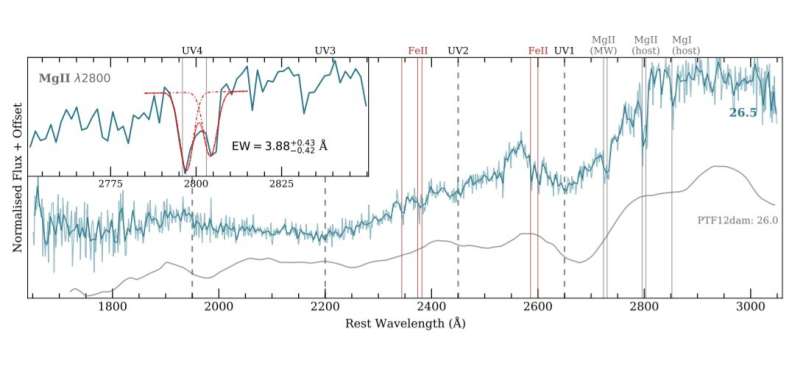February 14, 2022 report
Nearby superluminous supernova has an aspherical circumstellar material, study suggests

An international team of astronomers has performed spectroscopic observations of a nearby Type I superluminous supernova known as SN 2018bsz. The observational campaign sheds more light on the properties of this supernova, suggesting that it showcases aspherical circumstellar material. Results of the study were presented in a paper published February 3 on arXiv.org.
Supernovae (SNe) are powerful and luminous stellar explosions. They are important for the scientific community as they offer essential clues into the evolution of stars and galaxies. In general, SNe are divided into two groups based on their atomic spectra: Type I and Type II. Type I SNe lack hydrogen in their spectra, while those of Type II showcase spectral lines of hydrogen.
Superluminous supernovae (SLSNe) are characterized by exceptionally bright, often long-lived light curves. Interaction of the SN ejecta with surrounding circumstellar material (CSM) is an efficient mechanism to convert kinetic energy of the ejecta into radiation and it is assumed that such process may power SLSNe.
SN 2018bsz was first detected on May 17, 2018 by the All Sky Automated Survey for SuperNovae (ASAS-SN). The event was initially classified as a Type II SN. However, further monitoring of this source proved that it is a Type I SLSN (SLSN-I). The host galaxy of SN 2018bsz is 2MASX J16093905-3203443, at a redshift of 0.0267, which makes this supernova the closest SLSN-I discovered so far.
Previous photometric observations of SN 2018bsz have found that it exhibits some peculiar features, like unusual pre-peak plateau and evidence for rapid formation of dust. A team of astronomers led by Miika Pursiainen of the Technical University of Denmark, has recently observed this SN using various facilities worldwide and found that its spectroscopic and polarimetric properties are unique as well.
The researchers monitored the evolution of SN 2018bsz and detected multi-component hydrogen-alpha emission emerging at about 30 days after the supernova's post-maximum light, what is highly unusual for SLSNe-I. This suggests that the hydrogen is external to this SN and is located in the CSM.
The astronomers assume that the existence of asymmetric, disk-like CSM structure with several emitting regions may explain the observed spectroscopic evolution of SN 2018bsz. They propose a scenario in which upon the explosion the CSM would be overtaken by the ejecta, allowing only the blue component to be seen. Afterward, as the ejecta-driven photosphere recedes, the CSM reemerges and the blue and red emission components become visible.
"The CSM disk is quickly enshrouded by the expanding ejecta hiding any CSM emission lines and giving rise to a typical ejecta spectrum. As the ejecta photosphere eventually starts to recede, the CSM disk re-emerges producing the prominent multi-component emission lines," the researchers explained.
According to the authors of the paper, spectropolarimetric observations obtained during both the ejecta- and CSM-dominated phases seem to confirm the proposed scenario. They added that this asymmetric disk-like CSM of SN 2018bsz is highly inclined with respect to our line of sight.
Summing up the results, the scientists noted that their study underlined how unique SN 2018bsz is among other SLSNe-I as only a few of them exhibit late hydrogen emission, but only in this SN it is multi-component.
More information: SN 2018bsz: a Type I superluminous supernova with aspherical circumstellar material, arXiv:2202.01635 [astro-ph.HE] arxiv.org/abs/2202.01635
© 2022 Science X Network




















